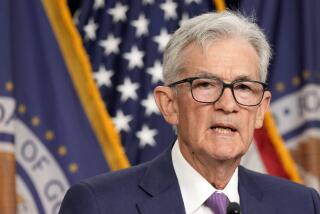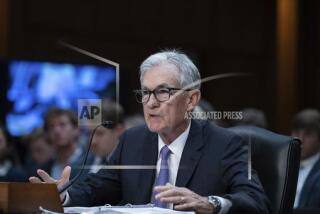Pick your poison
- Share via
When economist Ben Bernanke took the job as chairman of the Federal Reserve’s Board of Governors two years ago, pundits said his biggest challenge would be to fill the outsized shoes of his near-mythical predecessor, Alan Greenspan. Unfortunately for Bernanke, that now seems easy compared with the actual demands of the job.
Greenspan left the Fed in January 2006 with the economy fully recovered from the 2001 downturn. The Fed had amped economic growth by driving interest rates down for 3 1/2 years before leading them up slowly and delicately. Bernanke, who was seen as something of an inflation hawk, was expected to continue ratcheting up rates to a moderate level in the hope of steering the overheated housing market toward a “soft landing.”
So much for that. As his bleak testimony to Congress last week indicated, inflation isn’t at the top of Bernanke’s list now. And that’s not because inflation is comfortably low. On the contrary, it has turned up sharply in recent months as a result of higher commodity and food prices and the unusually weak dollar. But the more pressing problem for the Fed is the protracted tightening in the credit markets, which some analysts say is a crisis that could cause some banks to fail. That tightening, combined with the related crash in the housing market and drop in U.S. consumer spending, has driven us to the brink of recession.
It is practically conventional wisdom now that Greenspan’s decisions contributed to the sub-prime lending fiasco at the heart of today’s economic malaise. Not only were interest rates kept too low for too long, but the Fed and other policymakers looked the other way as lenders shoveled huge sums into the hands of unqualified borrowers. Such lax regulation continued well into Bernanke’s tenure. By the time the weakness in those loans was exposed, it was too late to stop the problem from metastasizing to investors and financial institutions around the world.
Bernanke appears to have responded well so far, moving with more alacrity and creativity than his predecessor. He’s found new ways to help banks manage the devalued assets on their books and pump money into the system without cutting the Fed’s target interest rate precipitously. Some critics say he’s been so responsive to economic indicators that he’s thrown off a whiff of panic. But Bernanke’s expertise as an academic is in the Depression, a period when the Fed underestimated the problems and reacted far too slowly. That history seems to guide him now.
Nevertheless, there’s only so much the Fed can do to redirect the economy. Unless lenders act quickly to avert a wave of foreclosures, the next couple of years could be worse than Bernanke predicted. What the Fed is most effective at doing is fighting inflation, and that must remain a priority even if a recession occurs. Low inflation is a critical ingredient in the kind of broad economic growth that can lift more Americans into prosperity. And as Bernanke well understands, a key part of the task is in managing the public’s self-fulfilling expectations that prices will rise and buying power shrink.
The Fed’s bet is that the recent increase in inflation is just a bump, not a ramp. That seems like a reasonable bet for now; inflation tends to linger before weakening in an economic downturn. But Bernanke can’t keep the Fed’s foot on the economic gas without risking a prolonged run-up in prices.
In a way, it’s pick-your-poison time for the Fed as it faces tightening credit, increasing unemployment, dwindling consumer spending and rising prices. Bernanke came into the job with a great deal of credibility on inflation. The test in his third year will be whether he can keep that credibility by raising rates before it’s too late.
More to Read
Inside the business of entertainment
The Wide Shot brings you news, analysis and insights on everything from streaming wars to production — and what it all means for the future.
You may occasionally receive promotional content from the Los Angeles Times.










